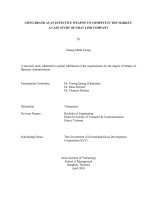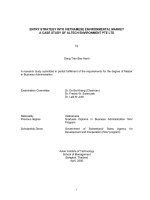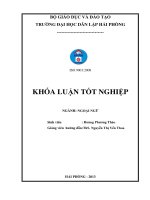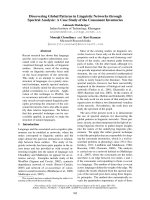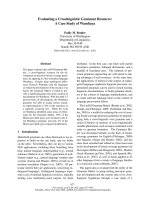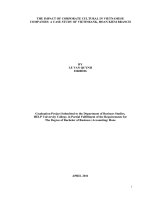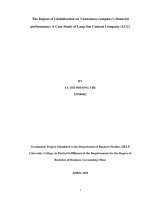Capital adequacy measurement a case study of an binh commercial joint stock bank
Bạn đang xem bản rút gọn của tài liệu. Xem và tải ngay bản đầy đủ của tài liệu tại đây (1.09 MB, 80 trang )
MINISTRY OF EDUCATION AND TRAINING
UNIVERSITY OF ECONOMICS HOCHIMINH CITY
FALCUTY OF BANKING
MBA PROGRAM
Capital Adequacy Measurement
A CASE STUDY OF AN BINH COMMERCIAL
JOINT STOCK BANK
Thesis made by
NGUYEN THANH PHONG
Thesis Tutor:
Assoc. Prof., Ph.D. Tran Hoang Ngan
Vice Rector of HCMC University of Economics
06/2010
Ho Chi Minh City
Acknowledgements
To achieve this thesis, I would like to convey my sincere thanks and appreciation to
the Economics University of Ho Chi Minh City , MBA program officers who have
facilitated and helped me with all their kindness and assistance.
My special thanks to Ms. Pham Thanh Thuy, Director of Treasury Division of An
Binh Commercial Joint Stock Bank, Mr. Vo Van Nhuan, Vice Head of Financial
Accounting Department, of ABBank, Mr. Nguyen Cong Anh and Ms. Tuy Loan,
Expert of Financial Accounting Department of An Binh Commercial Joint Stock
Bank who created favorable conditions, gave me relevant data and helped me to
carry out significant analysis and CAR measurement jobs during the time I had been
doing this research dissertation.
From DHL- VNPT Express Ltd., I appreciate Mr. Do Huu Anh, Deputy General
Director, Ms Dao Thi Ngoc Anh who have supplied me valuable data, information
and edited this research. All of us have had good cooperation during the time of this
thesis being done.
Apart from the above mentioned, Mr. Nguyen Huu Nhan, Mr. Ngo Tran Kien Quocmembers of MBA Banking class, Dr. Truong Tan Thanh- lecturer of Investment
analysis and portfolio management and my wife having encouraged and helped me
with all their hearts made me more confident and delighted to carry out this research
dissertation.
I would like to say that a lot of thanks are owed, in particular, to the assistance and
guidance from Assoc. Prof., Ph.D. Tran Hoang Ngan, Vice Rector of Ho Chi Minh
City Economics University. Ph.D. Tran Hoang Ngan, the tutor has encouraged and
given me a lot of advice on doing this thesis. Without Ph.D. Tran Hoang Ngan‘s
advice, a lot of difficulties would surely arise during my performance on this task.
Once again, all assistance helping me with this thesis is highly appreciated.
i
Abstract
In current age, globalization of financial institutions is a characteristic point and
unavoidable trend that make each country have to establish a banking management
system to protect against financial risks, to reinforce transparency in the banking
payment system and to tighten regulation on capital adequacy.
In order to conduct the opening door policy and integrate intothe world economy,
implement commitments of the WTO, Vietnam has many efforts to apply
international standards in capital banking management. In 2005, SBV issued the
Decision 457/2005 promulgating the regulation on safety assurance ratio in
activities of credit institutions and they continued to grant the Decree number
141/2006 date the January 1st, 2006 required Vietnamese commercial banks to have
a chartered capital of 3,000 billion VND at the end of 2010 which were seen the
interest of SBV in capital fund of commercial banks. The research problem of the
thesis is to examine the adequacy of bank capital in Vietnamese banking system
through a case study of An Binh Bank.
In term of structure, the research study has six chapters. Chapter One and Two
review research background, scope of work, methodology, significance of the study,
risk in banking operation and banking capital adequacy. Chapter Three introduces
research methodology is carried out in the thesis. Chapter Four and Five present an
overview of CAR measurement in Vietnamese banking system and survey results
obtained from a real model. Chapter Six provides some conclusions and
recommendations from the research.
With the finding as presented above, the dissertation provides many implications to
be able to improve in banking capital adequacy management in Vietnamese
commercial banks.
ii
Glossary of terms and abbreviations
SBV
State bank of Vietnam
SOCBs
State owned commercial banks
JSCBs
Joint stock commercial banks
SPBs
Social policy bank
JVBs
Joint-venture banks
FBBrs
Foreign bank branches
FFOBs
Fully foreign owned banks
VAR
Value at risk
ORM
Operational Risk Management
ALM
Asset Liability Management
ALCO
Asset Liability Committee
ABB
An Binh Commercial Joint Stock Bank
FRB
the Federal Reserve Board
FRS
the Federal Reserve System
FDIC
Federal Deposit Insurance Corporation
OCC
The Office of the Controller of the Currency
RWAs
Risk- weighted assets
US
the United States
OECD
The Organization for Economic Co-operation and Development
BIS
Bank for International Settlements
CAR
Capital adequacy ratio
GDP
Gross domestic product
IBRD
International Bank for Reconstruction and Development
EBRD
European Bank for Reconstruction and Development
ADB
Asian Development Bank
AfDB
Africa Development Bank
iii
EIB
European Investment Bank
IADB
Inter- American Development Bank
ACB
Asia Commercial joint stock Bank
STB
Saigon Thuong Tin Commercial Join Stock Bank
VCB
Vietnam Foreign Trade Commercial Join Stock Bank
Vietinbank
Vietnam Joint Stock Commercial Bank for Industry and Trade
EAB
Eastern Asia Commercial Joint Stock Bank
TCB
Technological and Commercial Joint Stock Bank
EIB
Export Import Commercial Bank
OCB
Orient Commercial Joint Stock Bank
NAB
Nam A Commercial Joint Stock Bank
SCB
Saigon Commercial Joint Stock Bank
HDB
Hochiminh City Housing Development Joint Stock Bank
VBSP
Vietnam Bank for Social Policies
VDB
Vietnam Development Bank
BIDV
Bank for Investment and Development of Vietnam
MHB
Mekong Housing Bank
VBARD
Vietnam Bank of Agriculture and Rural Development
DAB
Dong A Bank
MB
Military Bank
VIB
Vietnam International Bank
ROA
Return on Assets
ROE
Return on Equity
EPS
Earning per Share
PCC
Primary capital components
TA
Total assets
AfL& LL
Allowance for loan and lease losses
ATRR
Allocated transfer risk reserves
SCC
Secondary capital components
iv
Table of Contents
Acknowledgements......................................................................... i
Abstract.......................................................................................... ii
Glossary of terms and abbreviations .......................................... iii
Table of Contents ...........................................................................v
List of Tables ................................................................................ ix
List of Figures.................................................................................x
Chapter One: Introduction........................................................... 1
1.1
INTRODUCTION............................................................................. 1
1.2
RESEARCH BACKGROUND.......................................................... 1
1.3
RESEARCH PROBLEMS................................................................. 3
1.3.1
RESEARCH OBJECTIVES................................................................ 3
1.3.2
RESEARCH QUESTIONS.................................................................4
1.4
SCOPE OF WORK AND LIMITATION .......................................... 4
1.5
METHODOLOGY............................................................................ 5
1.6
SIGNIFICANCE OF THE STUDY ................................................... 5
1.7
STRUCTURE OF THE STUDY........................................................ 5
Chapter Two: Literature survey .................................................. 7
2.1
INTRODUCTION............................................................................. 7
2.2
RISK IN BANKING OPERATION................................................... 7
2.2.1
BANKING RISK OVERVIEW ..........................................................7
2.2.1.1 Credit risk.......................................................................................7
2.2.1.2 Market concentrate risk ..................................................................8
v
2.2.1.3 Interest rate risk..............................................................................8
2.2.1.4 Funding risk ...................................................................................8
2.2.1.5 Foreign currency risk......................................................................8
2.2.1.6 Economic risk.................................................................................9
2.2.2
2.3
BANKING RISK MANAGEMENT ORGANIZATION.....................9
ADEQUACY OF BANK CAPITAL ............................................... 10
2.3.1
REGULATIONS OF ADEQUATE CAPITAL ................................. 11
2.3.1.1 Uniform capital requirements ....................................................... 12
2.3.1.2 Risk- adjusted capital requirements .............................................. 14
2.3.2
REGULATORS’ VIEW POINTS ..................................................... 16
2.3.3
BANKERS’ VIEW POINTS ............................................................. 17
2.4
CONCLUSIONS ............................................................................. 17
Chapter Three:............................................................................ 18
Research methodology ................................................................ 18
3.1 DEFINE RESEARCH PROBLEM AND ESTABLISH RESEARCH
OBJECTIVES ........................................................................................... 18
3.2
DETERMINE AND COLLECT DATA .......................................... 18
3.3
EVALUATE AND ANALYZE DATA........................................... 19
3.4
RECOMMENDATIONS AND CONCLUSIONS ............................ 20
Chapter Four:.............................................................................. 21
An overview of CAR measurement in Vietnamese banking
system........................................................................................... 21
4.1 VIETNAMESE BANKING STRUCTURE.......................................... 21
4.2
REAL ACTIVITIES OF VIETNAMESE COMMERCIAL BANKS 23
4.2.1
ACHIEVEMENTS ........................................................................... 23
4.2.1.1 Number of commercial banks increased annually ......................... 23
vi
4.2.1.2 Mobilizing and supplying a large amount of funds........................ 24
4.2.1.3 Increasing chartered capital .......................................................... 26
4.2.2
SHORTCOMINGS........................................................................... 27
4.2.2.1 Bank- based financial system........................................................ 27
4.2.2.2 Bad debts of state owned commercial banks ................................. 28
4.2.2.3 Small equity capital ...................................................................... 28
4.2.2.4 Traditional and mono banking services......................................... 29
4.3 CAR REGULATIONS IN VIETNAMESE BANKING SYSTEM........ 32
Chapter Five:............................................................................... 35
Capital adequacy ratio measurement analysis in ABBank ...... 35
5.1
ABBANK OVERVIEW .................................................................. 35
5.1.1
CORPORATE INFORMATION...................................................... 35
5.1.2
MILESTONE AND VISION ............................................................ 35
5.1.3
BANK’S ORGANIZATION, PRODUCTS AND SERVICES ........... 36
5.2
ROLE OF ALCO ............................................................................ 37
5.2.1
TARGETS OF ALCO ...................................................................... 38
5.2.2
TASKS OF ALCO............................................................................ 38
5.2.3
CONTENTS OF THE REPORT SUBMITTED TO ALCO ............... 39
5.3
CAPITAL MANAGEMENT IN ABBANK..................................... 39
5.3.1
REGULATIONS IN SAFETY.......................................................... 40
5.3.2
SUPERVISION ................................................................................ 42
5.3.3
DEBIT CLASSIFICATION AND RISK PREVENTION .................. 42
5.3.4
FOREIGN EXCHANGE STATUS ................................................... 43
5.3.5
DEPOSIT INSURANCE .................................................................. 44
5.4
ABBANK’S CAPITAL ADEQUACY ............................................ 44
5.5
CAR CALCULATED ACCORDING TO SBV IN COMPARISON
WITH PRIMARY CAPITAL TO ASSET RATIO (FRB) .......................... 49
vii
Chapter Six: Recommendations................................................. 52
6.1
QUALITY OF ASSET .................................................................... 52
6.2
INCREASING THE CURRENT CAR ............................................ 52
6.3 APPLYING STANDARDS OF BASEL II IN VIETNAMESE
COMERCIAL JOINT STOCK BANKS..................................................... 52
Conclusions.................................................................................. 54
Bibliography ................................................................................ 56
List of appendices........................................................................ 58
viii
List of Tables
Table
Page
4.1
Number of commercial bank 2004- 2008
23
4.2
Chartered capital of Vietnamese commercial banks
27
4.3
CAR of Vietnamese commercial banks from 2003 to 2008
33
5.1
Specific provision for debts
43
5.2
Total assets and capital in ABBank from 2006 to 2009
45
5.3
Capital adequacy ratio in ABBank 2006- 2009
48
5.4
Calculating CAR in accordance with different ways
50
ix
List of Figures
Figures
Page
2.1
Asset/ Liability management structure
10
3.1
Chart of research framework
20
4.1
Chart of commercial bank types
24
4.2
Fund mobilization and loan outstanding from 2001 to 2008 by
25
Vietnamese commercial banks
4.3
Growth rate of fund mobilization and loan outstanding
25
4.4
Credit market share of commercial banks
29
4.5
Top 10 banks are traded the best
31
4.6
Customer’s satisfactory ratio
32
4.7
CAR chart of Vietnamese commercial banks
34
5.1
ABBank’s Board of Director
36
5.2
Total assets and owned capital of ABBank
46
5.3
Capital adequacy ratio of some commercial banks from 2006 to
48
5.4
Owned adequacy/ Total asset of commercial banks
48
5.5
Chart of CAR according to different calculation
51
2008
x
Chapter One: Introduction
Chapter One: Introduction
1.1 INTRODUCTION
Banks undertake a variety of functions which assists the operation of the economy
and the general community. The most important function of these is the provision of
payment service and it acts as financial intermediaries between savers and
borrowers. In this role, banks pool the community’s saving, thereby increasing
liquidity and avoid the risk of investing funds with a few borrowers- household or
businesses when approaching banks or other financial intermediaries do not face the
cost of approaching a large number of small savers to meet borrowers’ finance
needs. Lending and borrowing activities make banks take many risks caused by
from external and internal factors such as business risk, financial risk, liquidity risk,
exchange risk and country risk as well. That requires banking managers to consider
about the risk management. The risk management in financial institutions is
sophisticated and its purpose is to optimize the uncertainty and to create the value by
maximizing return available for a given level of risk.
Banking business activities are sensitive and highly spread into a whole system. Any
social volatilities which affect on banking the downturn of banking system are able
to make bad results on national economy. Thus, with the role as a central place of
national payment system, banking management, especially capital management is
crucial to absorb the volatility of economy affected in banking system and build in
the confidence on the customers. Bank capital must be sufficient to protect a
financial organization’s depositors and counterparties from the risks of the
institution's on- and off-balance sheet risks.
1.2 RESEARCH BACKGROUND
Vietnamese banking system has been executing a careful process of reform which
has resulted in the restructure of its large monobank. The process has created four
public sector banks including state owned commercial banks (SOCBs), joint stock
commercial banks (JSCBs), foreign banking and credit cooperatives. JSCBs only
1
Chapter One: Introduction
account for 15% of banking sector assets, but they are considered more rapid
growth than SOCBs. Their operations are concentrated on major urban areas and
focus on providing credit to small and medium sized companies and retail banks.
JSCBs’ services are various and new technologies have been applied in operation
and management on the purpose to give the best service to consumers. JSCBs’
banking activity are supervised by SBV and board of management. The reform has
made Vietnamese banking system operated better and contributed significantly in
economic growth. With the role of financial intermediary, Vietnamese banking
system has been contributed positively to maintain high economic growth
continuously in last years. With the outstanding loan of economy making up 35%
to 37% of GDP, annually, banking system has contributed over 10% of overall
Vietnamese economic growth rate.
Business downturn has occurred since the end of year 2008 with the bankruptcy of
big banks in the world such as Lehman Brother and Citibank that have been the
signals of financial regression. In the year 2009, the business overview in the world
has become more serious as American business has fallen in crisis which has caused
the financial crisis in most of countries. In this context, Vietnamese commercial
banks which have low level of management and weak capital base are able to be
impacted by global crisis influences. In order to deal with the downturn, SBV is not
only to maintain a tighten monetary policy but also to grant many regulations to
maintain the banking operation system and limit the credit risk. Vietnamese
commercial banks are concentrated on two main targets: increasingly lending and
borrowing operation but assure capital safety.
Moreover, the integration process requires Vietnam have to be aligned with
international treaties and global standards in banking management that will ensure
the safety and soundness of global financial system. Capital fund of commercial
banks in total assets and deposits have become an issue regarding to adequacy of
bank capital.
2
Chapter One: Introduction
1.3 RESEARCH PROBLEMS
Bank regulators in most countries and international bank supervisory agencies have
taken into account of capital adequacy by setting up many regulations of bank
capital, in which, Basel I and Basel II proposed by the Basel Committee have been
aligned with member states. To do opening- door and integration policy, Vietnam
has made many efforts to renovate economy and implement the WTO’s
commitments, in which banking service is the area of deeper integration and the
widest. Vietnamese banking system has just aligned with a part of standards in the
Basel I about credit risk and forecast to do fully the standard in 2010. Vietnamese
commercial banking system will have to prepare in long time before applying the
Basel II. Therefore, being aware of bank capital and capital adequacy problem are
key factors in management for Vietnamese regulators and banking managers. The
problem to be addressed in the thesis is the capital adequacy in Vietnamese
commercial banks through studying a case study in An Binh Joint Stock
Commercial Bank. (ABBank)
The case study has been done in An Binh Joint Stock Commercial Bank which
adequate capital is so high, its operation is not so complicated as more than 90% of
its income mainly come from credit activity. Scale of total capital in ABBank is
average and it will not encounter with the pressure of increasing capital over three
billion Vietnamese dong in 2010. This is one of Vietnamese commercial banks
having big ambitious strategy to extend banking market share and the most
important is that the research can find quite enough data for the research purpose.
1.3.1
RESEARCH OBJECTIVES
In solving the research problem, the research study examines the calculation of
CAR in ABBank to answer research questions. The main objective of this research is
to find out capital adequacy management in Vietnamese banking system through a
real model. Upon the case have been studied in ABBank, the thesis emphasizes the
importance of CAR to ensure the safety and the soundness in financial banking
system. In addition, other objective of the research is to present the compliance of
3
Chapter One: Introduction
SBV with standards of Basel I before Vietnam has to apply new international
standards such as the Basel II.
1.3.2
RESEARCH QUESTIONS
The research problem is defined and translated into research questions. The research
study leads to the following research questions:
- Why bank managers and regulators have to be interested in the capital
adequacy?
- How does ABBank measure capital adequacy ratio under SBV’s regulations?
- Is there the significant difference between the measurement of CAR
according to SBV’ rules with primary capital to asset ratio?
- What action can improve capital adequacy in Vietnamese commercial banks?
1.4 SCOPE OF WORK AND LIMITATION
Completing the dissertation combines aspects theory with practice. For theory, this
study replies on main contents of the Basel I and current regulations of SBV relating
to capital management and assurance of safety ratio in activities of credit institutions
in Vietnam. The research also uses theory of FDIC’s Capital Adequacy Act to
discuss on primary capital to assets method. In addition, utilizing data collected
from ABBank to calculate CAR and analyze capital management in the thesis.
Moreover, data of commercial banks in HCMC area published in the public media
such as newspapers, magazine, internet being utilize in the study.
As presenting on the research problem, Vietnam needs to have more conditions
about expenses, qualified human resources, system guidelines to apply the Basel II
in Vietnam. Therefore, the dissertation focuses on standards of the Basel I are
implemented in Vietnamese banking system via ABBank’s case study. Some of data
collected such as CAR are gathered at the end of year when they can differentiate
from data at the point to publish information popularly. Analytical data are collected
in 3 years and because of being problems in accessing and collecting information of
the entire banking system, the research just compares the data from commercial
banks doing business in Ho Chi Minh City area.
4
Chapter One: Introduction
1.5 METHODOLOGY
The researcher determines the research methodology depending upon their research
question. The thesis is designed to describe characteristics of adequacy capital
practice of Vietnamese commercial banks. Thus, descriptive research is chosen for
this study. The research study uses the qualitative method combined with
quantitative method. Data collected from multiple sources including direct reports,
surveys, interviews, documentation review and observation.
1.6 SIGNIFICANCE OF THE STUDY
The research is significant for capital management practice in Vietnam. Results will
point out a real model doing adequate capital management in Vietnamese banking
system. Through a real case of ABBank applying the Basel I in capital adequacy
management, Vietnamese regulators and banking managers learns useful lessons in
banking capital management and strongly implements the Basel II which have been
updated and renovated more better than the Basel I in capital adequacy measurement
in future.
1.7 STRUCTURE OF THE STUDY
This research study is structured as follows:
Chapter One: The introduction provides the general introduction of the research
study, rational of the research, problem statement, objectives, research methodology,
scope and limitations.
Chapter Two: The Literature Survey reviews details, definition, secondary data
and industry reports about banking risk management, capital adequacy management
and capital adequacy ratio calculation based on international standards. Then the
research study come to the review of the research process, industry and SBV’
regulations in order to have the right technique to carry out this research.
Chapter Three: The Research methodology mentions the methodology data
analysis finding, in which the research study defines the research study, how to
5
Chapter One: Introduction
collect primary and secondary data. Both qualitative and quantitative research
methods are also mentioned in this chapter.
Chapter Four: An overview of CAR measurement in Vietnamese banking
system introduces general characteristics of banking system in Vietnam. In addition,
good and bad point of Vietnamese commercial banks is also highlighted in this
chapter.
Chapter Five: CAR measurement analysis in ABBank presents the survey results
in one of Vietnamese commercial bank about the adequate capital, measurement of
CAR.
Chapter Six provides some recommendations to increase the capital management
of An Binh Joint Stock Bank and to strengthen the capital adequacy management in
Vietnamese Commercial Join Stock Banks.
The last section is the conclusions to make a brief summary of the results achieved.
6
Chapter Two: Literature survey
Chapter Two: Literature survey
2.1 INTRODUCTION
Banking system is very important role in the economy at most countries.
Commercial banks, one type of banks are the heart of paymenst system which
control and settle customers financial transactions. Besides major role of
commercial banks in payment settlement, other financial institutions such as saving
and loan, saving bank, credit union, money market mutual funds and brokerage
firms offer transaction account, as well. Role of bank in payment system takes on an
important social dimension because an efficient payments system is vital to
economic stability and growth (Benton and James, 2005). In addition, banking
system keeps a role of financial intermidiary obtain fund from surplus fund of
depositors and investors and lend the loans to borrowers. Banks mobilise deposits by
offering instruments with wide variety denomination, interest rate, and maturities.
This role is very important because the stability and growth in nation’s economy
depend on the large volume of saving and the effective allocation of loan. Last but
not least, banks would provides other financial services to customers including off
balance sheet activities, Insurance and securites related activities and trust services.
The health of banking system has influenced on the development of economy.
2.2 RISK IN BANKING OPERATION
2.2.1
BANKING RISK OVERVIEW
Bank is a risky business. The nature of banking is such that risks are inherent in
almost every aspect of banking business (Budge, 1988). Bankers have faced with
various uncertainties that can make negative effects in banking operation. Basically,
the banking activities have been impacted the following risks:
2.2.1.1
Credit risk
This is the main risk threaten stability of bank as that is posible loss of principal and
interest because of default of borrowers. Credit risk arisen by counterparty can not
meet the contractual payment and that is influenced directly on the bank or on the
7
Chapter Two: Literature survey
third party where the bank has guaranteed the primary borrowers performance
(Budge, 1988)
2.2.1.2
Market concentrate risk
The risk is an extension of credit risk which is interested in banking risk
management. Individual or interprises did not diversify their portfolio investment in
banking product when they invest in one banking product or service. As a result,
when dificulties or failures of the customers threaten the stability of banks. It does
not place too many eggs in one basket and this is the best investment way to avoid
this risk
2.2.1.3
Interest rate risk
Interest rate risk is the risk impacts on the balance of bank’s balance sheet due to a
mismatch between booking value assets and liabilities. The mismatch can be
negative or positive which depends on when assets are repriced and the fluctuation
of floating interest rate exits in financial market. A negative profit happens if
bankers reprice asset later than liabilities and interest rates increase or the liabities
are repriced later than later than its asset and interest rate decrease.
2.2.1.4
Funding risk
Funding risk or liquidity risk reflects the situation in which banks are not enough
liquid fund to meet the demand to withdraw fund due to a mismatch between assets
and liabilities maturites. This risk causes problems if the bank does not have surplus
liquidity or the ability evaluate the fluctuation on the market that affect on the
withdrawal of fund.
2.2.1.5
Foreign currency risk
In reality, banking business in countries occurs in the global market that mean they
deal in a great of currencies thus they disclose themselves to potential foreign
currency risk. The foreign exchange risk is the risk that the value of assets and
liability will change because the exhange rate is fluctuated by the international
obligation of foreign curency. There are two types of foreign exchange risk. The
former happens in trading transaction as the fluctuation exchange rate impacts on
the settlement value by foreign currency at a future date at a pre-contracted rate. The
8
Chapter Two: Literature survey
risk araise where there is either a mistmatch of buying or selling contracts or one
side of trading contract fail to delivery on a counterparty (Budge, 1988). The later is
of a structural nature that involves a dispropotion of long term assets and liabilities
between forein currencies.
2.2.1.6
Economic risk
Economic risk or enviromental risk is the risk concern with appreciating and
understanding how nation’s economy and financial market will change in the future
which create uncetainties to the banking system and impact, as a result, on the
customer’s benefit. The bankers only minimize the risk by sound analysis of the
business environment and predict the broad trend affecting directly or indirectly on
the business of bank in future.
Even through banking business always encounters with many risk are inherent in all
aspect of it activity, banks still maintain their activities effectively through their
ability to control the risk they face.
2.2.2
BANKING RISK MANAGEMENT ORGANIZATION
The core ALM function is the control and management of the bank’s assets,
liabilities and capital base. The balance sheet can be controlled through defensive or
aggressive asset/ liability management. The purpose of defensive or aggressive
asset/ liability management is to separate the net interest income out of the impact of
changing interest rate. ALM unit establishes the ALM process to control risk and
return management.
A well definition of ALM process is considered that ALM function involves
planning, directing and controlling the flow, level, mix, cost& yield of the
consolidated funds of the corporation. These responsibilities are interwoven with
and overall objectives of achieving the corporation’s financial goals and controlling
financial risks (John and Goddard,1992 )
In bank’s management, a committee consist of the senior executive thoroughly
familiar with finance and interest rate theory will be responsible for the asset and
liability management The task of ALCO including:
Studying the trend of loan demand and interest rate to set up the base rate.
9
Chapter Two: Literature survey
Discussing market shares and performance of various banking groups.
Maintaining and enhance the institution’s capital position.
Reviewing and making the change gradually in banking business
Board of Directors
Chief Executive Officer
Asset/ Liability Committee
Chief
Executive
Chief Financial Officer
Treasure
Senior Lending Officer
Senior Liability (Deposits)
Senior Investment Officer
Figure 2..1: Asset/ Liability Management structure
(Source: John W. Bitner with Robert A. Goddard (1992), successful bank asset/
liability management)
2.3 ADEQUACY OF BANK CAPITAL
Generally, bank capital is described as shareholder’s funds in the commercial banks
and serves significant functions. Firstly, bank capital acts as a buffer against
unidentified losses occurring in future that banks may incur. A bank must hold
enough capital to cushion both depositors and senior lenders against losses, while
leaving the bank able to meet the needs of its customers (William, 1999). The
10
Chapter Two: Literature survey
second function of capital in bank is a source of funds to buy tangible assets. The
final function of bank capital relating to the question of adequate capital. This is a
difficult concept because the ratio of capital on asset is small while banks need to
cover all potential losses in future to protect creditors and to guarantee the safety
and the soundness in financial system. Karlyn (1984) states that the capital
adequacy issue arose because bankers who try to maintain capital adequacy to
attract deposits and operate profitably while bank supervisors try to maintain capital
adequate to protect the depositors and promote a sound financial system.
2.3.1
REGULATIONS OF ADEQUATE CAPITAL
The history of development in banking sector showed that many capital adequacy
standards have been established and changed those standards many times to fix with
the variability of financial system in the world.
In the early 1900s, when the deposit running is the major reasons to threaten the
strength of bank, the Office of the Comptroller of the Currency (OCC) concentrated
on bank’s capital to deposit ratio to measure capital adequacy.
During World war II, a capital to risk asset ratio is utilized by regulators, where the
term losses on risky asset was considered to the main cause for bank risk.
Over the last fifty years, a large of methodologies has been applied to assess capital
adequacy. For instance, in the 1950s, the Federal Reserve Board (FRB) used Form
for Analyzing Bank capital (FABC) to divide assets into six risk categories and each
of categories is required a different percentage of capital. With small banks, capital
requirement was higher because of the perception that the diversification of their
portfolio less than large banks. By contrast, strict instructions in the early 1960s in
favor of more subjective evaluation based on many components such as
management quality, asset liquidity, ownership, operating expenses and deposit
composition were abandoned by the OCC. The guidance relative to capital
requirement is nonintegrated make banks become confusing in compliance with
those regulation. Another issue with capital standard has been their enforceability
and fairness. In the past, banking regulations were not supported by force of law in
most countries that make financial system operated unsuitable not only in national
11
Chapter Two: Literature survey
territory but also in the globalization. This problem was solved by the International
Lending Supervision Act of 1983 under which act, regulators set up a minimum
capital requirements and enforce them. Moreover, the implementation of guidelines
is unfair when the small banks were applied a restrictive capital requirement than
large bank because according to regulators, small bank usually encountered with
future uncertainty greater than large bank.
2.3.1.1
Uniform capital requirements
The discrimination in compliant with capital requirement has been occurred in every
country and across countries. In the United States, unfair discrimination treats
people such as African American, Hispanics and other minorities, foreign born
person and females. As trade has become globalization that make regulators to
standardize capital regulation in region and across nation as well. A uniform capital
requirement for international banks has been devised and adopted by those
developed countries with largest economies. Uniform capital standard has been
proposed for securities firm as well. International corporation by banking securities
regulators has been attempted and harmonization of domestics regulator has been
urged. In the United States, ratio of minimum primary capital to asset has been
established by federal bank regulators, in which FRB and OCC adopted specific
ratio of primary capital. The Board of Governors of the FRS has established a
minimum level of primary capital to total assets of 5.5 percent and a minimum level
of total capital to total assets of 6.0 percent. Accordingly, banking institutions are
expected to operate above the minimum primary and total capital levels. Those
organizations whose operations involve or are exposed to high or inordinate degrees
of risk will be expected to hold additional capital to compensate for these risks.
Under Capital Adequacy Act applied with bank holding companies and state
member banks, the Board has established the capital measurement including
Primary Capital Components
- Common stock,
- Perpetual preferred stock (preferred stock that does not have a stated maturity
date and that may not be redeemed at the option of the holder),
12
Chapter Two: Literature survey
- Surplus (excluding surplus relating to limited-life preferred stock),
- Undivided profits,
- Contingency and other capital reserves,
- Mandatory convertible instruments.
- Allowance for possible loan and lease losses (exclusive of allocated transfer
risk reserves),
- Minority interest in equity accounts of consolidated subsidiaries,
- Perpetual debt instruments (for bank holding companies but not for state
member banks).
Secondary Capital Components
- The components of secondary capital are:
- Limited-life preferred stock (including related surplus) and
- Bank subordinated notes and debentures and unsecured long-term debt of the
parent company and its nonbank subsidiaries.
(Appendix B—Capital Adequacy Guidelines for Bank Holding Companies and State
Member Banks: Leverage Measure)
Based on the common guidelines the Board has given the instruction of primary and
total capital asset ratio for both bank holding companies and state member banks
a) The primary and total capital ratios apply for bank holding companies
PCC
Primary capital ratio = ----------------------------------------TA + AfL& LL (exclusive of ATRR)
PCC + SCC
Total capital ratio = ----------------------------------------TA + AfL& LL(exclusive of ATRR)
b) The primary and total capital ratios for state member banks are
computed as follows:
13
Chapter Two: Literature survey
PCC - Goodwill
Primary capital ratio = -------------------------------------------------------------------Average TA + AfL& LL (exclusive of ATRR) - Goodwill
(PCC + SCC) - Goodwill
Total capital ratio = ----------------------------------------------------------------------Average TA + AfL& LL (exclusive of ATRR) - Goodwill
There are more improving uniformity in capital management by regulators since
1985 tending to settle a basic capital ratio for all banks so that capital standard were
monitored and protected capital from financial risk. However, the uniform capital/
asset ratio measuring capital sufficiency make undercapitalized bank raised capital,
cut off operating cost, increase services price and make riskier loans. These changes
can offset the benefit of increment capital in many cases and so defeated to some
extent the capital adequacy objectives of regulators. (Benton and James, 2005)
2.3.1.2
Risk- adjusted capital requirements
During the 1980s, regulator in the US and other industrial countries became concern
that capital- to- asset ratio established simple that required too much capital for safe
assets but deficient for riskier assets. Another relation was that the regulation did
not required any capital for portfolios of off- balance sheet which were growing
rapidly in operation of banking institution. These issues led to the development of
the risk based capital framework which was adopted by the Basel Committee on
Banking Supervision in 1988 and implemented at the end of 1992.
The First Basel Agreement (the Basel I) was signed in June 1988 under the
sponsorship of the BIS, in which the Agreement provided the international capital
standards and methods of measuring capital. The Basel I has clarified concepts
concerning core capital, supplementary capital, undisclosed reserves, asset
revaluation reserves, general provisions, general loan-loss reserves, hybrid debt
capital instruments, subordinated term debt, deductions from capital (Nguyen, 2006).
Assets of banks were classified and grouped in five categories according to credit
risk, carrying risk weights of zero (for example home country sovereign debt), ten,
twenty, fifty, and up to one hundred percent (this category has, as an example, most
14

